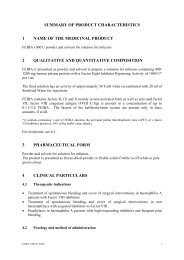Haemophilia in the Classroom - Haemophilia Care
Haemophilia in the Classroom - Haemophilia Care
Haemophilia in the Classroom - Haemophilia Care
- No tags were found...
You also want an ePaper? Increase the reach of your titles
YUMPU automatically turns print PDFs into web optimized ePapers that Google loves.
A teacher’s guide to <strong>Haemophilia</strong>What are <strong>the</strong> effects of haemophilia?It all depends on how severe <strong>the</strong> condition is.People with mild or moderate haemophilia do not really have many problems.Even though <strong>the</strong>ir blood clots more slowly than normal, <strong>the</strong> difference is onlylikely to cause concern after serious <strong>in</strong>juries or dur<strong>in</strong>g major surgery.Indeed, many of <strong>the</strong>se people are totally unaware that <strong>the</strong>y have haemophilia,and <strong>the</strong>ir condition would almost certa<strong>in</strong>ly not be such as to require any specialapproach on your part.However, <strong>in</strong> people with severe haemophilia, <strong>the</strong> clott<strong>in</strong>g mechanism is socompromised that <strong>the</strong>y can bleed even when <strong>the</strong>re is no obvious sign of <strong>in</strong>jury.The ma<strong>in</strong> problem is not from open cuts but from <strong>in</strong>ternal bleed<strong>in</strong>g.All of us damage small blood vessels <strong>in</strong> <strong>the</strong> course of everyday life and for mostof us, this causes no problem at all, as <strong>the</strong> bleed<strong>in</strong>g stops and <strong>the</strong> damage isrepaired–often before we even know it has started.For <strong>the</strong> person with haemophilia, once bleed<strong>in</strong>g starts, it goes on for longer,mean<strong>in</strong>g that even trivial <strong>in</strong>juries can lead to bleed<strong>in</strong>g <strong>in</strong>to <strong>the</strong> muscles and jo<strong>in</strong>ts,caus<strong>in</strong>g <strong>the</strong>m to become <strong>in</strong>flamed, swollen and pa<strong>in</strong>ful.An <strong>in</strong>cident such as this is referred to as ‘a bleed’ and requires treatment with an<strong>in</strong>travenous <strong>in</strong>fusion of <strong>the</strong> blood clott<strong>in</strong>g factor which is miss<strong>in</strong>g. Because repeatedbleeds can also lead to long term damage, particularly to <strong>the</strong> jo<strong>in</strong>ts, many peoplewith haemophilia now receive regular <strong>in</strong>fusions of factor, usually twice or threetimes a week, to prevent bleeds occurr<strong>in</strong>g <strong>in</strong> <strong>the</strong> first place. This type of treatment,called prophylaxis, is usually effective <strong>in</strong> prevent<strong>in</strong>g bleed<strong>in</strong>g which occurs for noobvious reason (spontaneous bleeds), and will reduce <strong>the</strong> severity of bleed<strong>in</strong>g asa result of <strong>in</strong>jury to a level close to that of any o<strong>the</strong>r child.09








